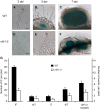Role of the Nod Factor Hydrolase MtNFH1 in Regulating Nod Factor Levels during Rhizobial Infection and in Mature Nodules of Medicago truncatula
- PMID: 29367305
- PMCID: PMC5868697
- DOI: 10.1105/tpc.17.00420
Role of the Nod Factor Hydrolase MtNFH1 in Regulating Nod Factor Levels during Rhizobial Infection and in Mature Nodules of Medicago truncatula
Abstract
Establishment of symbiosis between legumes and nitrogen-fixing rhizobia depends on bacterial Nod factors (NFs) that trigger symbiosis-related NF signaling in host plants. NFs are modified oligosaccharides of chitin with a fatty acid moiety. NFs can be cleaved and inactivated by host enzymes, such as MtNFH1 (MEDICAGO TRUNCATULA NOD FACTOR HYDROLASE1). In contrast to related chitinases, MtNFH1 hydrolyzes neither chitin nor chitin fragments, indicating a high cleavage preference for NFs. Here, we provide evidence for a role of MtNFH1 in the symbiosis with Sinorhizobium meliloti Upon rhizobial inoculation, MtNFH1 accumulated at the curled tip of root hairs, in the so-called infection chamber. Mutant analysis revealed that lack of MtNFH1 delayed rhizobial root hair infection, suggesting that excess amounts of NFs negatively affect the initiation of infection threads. MtNFH1 deficiency resulted in nodule hypertrophy and abnormal nodule branching of young nodules. Nodule branching was also stimulated in plants expressing MtNFH1 driven by a tandem CaMV 35S promoter and plants inoculated by a NF-overproducing S. meliloti strain. We suggest that fine-tuning of NF levels by MtNFH1 is necessary for optimal root hair infection as well as for NF-regulated growth of mature nodules.
© 2018 American Society of Plant Biologists. All rights reserved.
Figures












Comment in
-
Goldilocks Principle: MtNFH1 Ensures Optimal Nod Factor Activity.Plant Cell. 2018 Feb;30(2):267-268. doi: 10.1105/tpc.18.00114. Epub 2018 Feb 7. Plant Cell. 2018. PMID: 29436475 Free PMC article. No abstract available.
Similar articles
-
The nodulation factor hydrolase of Medicago truncatula: characterization of an enzyme specifically cleaving rhizobial nodulation signals.Plant Physiol. 2013 Nov;163(3):1179-90. doi: 10.1104/pp.113.223966. Epub 2013 Sep 30. Plant Physiol. 2013. PMID: 24082029 Free PMC article.
-
A single amino acid substitution in a chitinase of the legume Medicago truncatula is sufficient to gain Nod-factor hydrolase activity.Open Biol. 2016 Jul;6(7):160061. doi: 10.1098/rsob.160061. Open Biol. 2016. PMID: 27383628 Free PMC article.
-
Rhizobial infection is associated with the development of peripheral vasculature in nodules of Medicago truncatula.Plant Physiol. 2013 May;162(1):107-15. doi: 10.1104/pp.113.215111. Epub 2013 Mar 27. Plant Physiol. 2013. PMID: 23535942 Free PMC article.
-
How rhizobial symbionts invade plants: the Sinorhizobium-Medicago model.Nat Rev Microbiol. 2007 Aug;5(8):619-33. doi: 10.1038/nrmicro1705. Nat Rev Microbiol. 2007. PMID: 17632573 Free PMC article. Review.
-
Molecular Mechanisms of Intercellular Rhizobial Infection: Novel Findings of an Ancient Process.Front Plant Sci. 2022 Jun 23;13:922982. doi: 10.3389/fpls.2022.922982. eCollection 2022. Front Plant Sci. 2022. PMID: 35812902 Free PMC article. Review.
Cited by
-
Plant-Environment Response Pathway Regulation Uncovered by Investigating Non-Typical Legume Symbiosis and Nodulation.Plants (Basel). 2023 May 12;12(10):1964. doi: 10.3390/plants12101964. Plants (Basel). 2023. PMID: 37653881 Free PMC article. Review.
-
The rhizobial effector NopT targets Nod factor receptors to regulate symbiosis in Lotus japonicus.Elife. 2025 Apr 4;13:RP97196. doi: 10.7554/eLife.97196. Elife. 2025. PMID: 40183777 Free PMC article.
-
Legumes Regulate Symbiosis with Rhizobia via Their Innate Immune System.Int J Mol Sci. 2023 Feb 1;24(3):2800. doi: 10.3390/ijms24032800. Int J Mol Sci. 2023. PMID: 36769110 Free PMC article. Review.
-
Goldilocks Principle: MtNFH1 Ensures Optimal Nod Factor Activity.Plant Cell. 2018 Feb;30(2):267-268. doi: 10.1105/tpc.18.00114. Epub 2018 Feb 7. Plant Cell. 2018. PMID: 29436475 Free PMC article. No abstract available.
-
Genome-Wide Identification and Characterization of the Soybean DEAD-Box Gene Family and Expression Response to Rhizobia.Int J Mol Sci. 2022 Jan 20;23(3):1120. doi: 10.3390/ijms23031120. Int J Mol Sci. 2022. PMID: 35163041 Free PMC article.
References
-
- Ané J.M., et al. (2004). Medicago truncatula DMI1 required for bacterial and fungal symbioses in legumes. Science 303: 1364–1367. - PubMed
-
- Ardourel M., Demont N., Debellé F., Maillet F., de Billy F., Promé J.C., Dénarié J., Truchet G. (1994). Rhizobium meliloti lipooligosaccharide nodulation factors: different structural requirements for bacterial entry into target root hair cells and induction of plant symbiotic developmental responses. Plant Cell 6: 1357–1374. - PMC - PubMed
-
- Auriac M.C., Timmers A.C.J. (2007). Nodulation studies in the model legume Medicago truncatula: advantages of using the constitutive EF1α promoter and limitations in detecting fluorescent reporter proteins in nodule tissues. Mol. Plant Microbe Interact. 20: 1040–1047. - PubMed
-
- Baev N., Endre G., Petrovics G., Banfalvi Z., Kondorosi A. (1991). Six nodulation genes of nod box locus 4 in Rhizobium meliloti are involved in nodulation signal production: nodM codes for D-glucosamine synthetase. Mol. Gen. Genet. 228: 113–124. - PubMed
Publication types
MeSH terms
Substances
LinkOut - more resources
Full Text Sources
Other Literature Sources
Molecular Biology Databases

